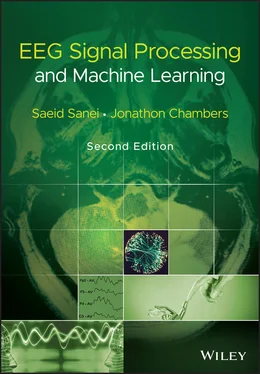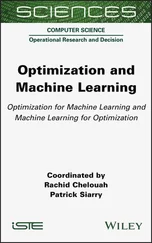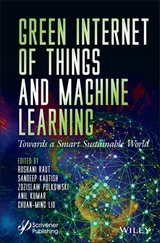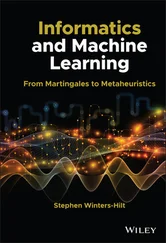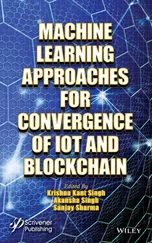Saeid Sanei - EEG Signal Processing and Machine Learning
Здесь есть возможность читать онлайн «Saeid Sanei - EEG Signal Processing and Machine Learning» — ознакомительный отрывок электронной книги совершенно бесплатно, а после прочтения отрывка купить полную версию. В некоторых случаях можно слушать аудио, скачать через торрент в формате fb2 и присутствует краткое содержание. Жанр: unrecognised, на английском языке. Описание произведения, (предисловие) а так же отзывы посетителей доступны на портале библиотеки ЛибКат.
- Название:EEG Signal Processing and Machine Learning
- Автор:
- Жанр:
- Год:неизвестен
- ISBN:нет данных
- Рейтинг книги:3 / 5. Голосов: 1
-
Избранное:Добавить в избранное
- Отзывы:
-
Ваша оценка:
- 60
- 1
- 2
- 3
- 4
- 5
EEG Signal Processing and Machine Learning: краткое содержание, описание и аннотация
Предлагаем к чтению аннотацию, описание, краткое содержание или предисловие (зависит от того, что написал сам автор книги «EEG Signal Processing and Machine Learning»). Если вы не нашли необходимую информацию о книге — напишите в комментариях, мы постараемся отыскать её.
EEG Signal Processing and Machine Learning — читать онлайн ознакомительный отрывок
Ниже представлен текст книги, разбитый по страницам. Система сохранения места последней прочитанной страницы, позволяет с удобством читать онлайн бесплатно книгу «EEG Signal Processing and Machine Learning», без необходимости каждый раз заново искать на чём Вы остановились. Поставьте закладку, и сможете в любой момент перейти на страницу, на которой закончили чтение.
Интервал:
Закладка:
References
1 1 van Vreeswijk, C., Abbott, L.F., and Ermentrout, G.B. (1994). When inhibition not excitation synchronizes neural firing. Journal of Computational Neuroscience 1: 313–321.
2 2 Penny, W.D., Litvak, V., Fuentemilla, L. et al. (2009). Dynamic causal models for phase coupling. Journal of Neuroscience Methods 183 (1): 19–30.
3 3 Ward, L. (2003). Synchronous neural oscillations and cognitive processes. Trends in Cognitive Sciences 7 (12): 553–559.
4 4 von Stein, A., Rappelsberger, P., Sarnthein, J., and Petsche, H. (1999). Synchronization between temporal and parietal cortex during multimodal object processing in man. Cerebral Cortex 9 (2): 137–150.
5 5 Jones, M. and Wilson, M. (2005). Theta rhythms coordinate hippocampal–prefrontal interactions in a spatial memory task. PLoS Biology 3 (12): e402.
6 6 Penny, W.D., Stephan, K.E., Mechelli, A., and Friston, K.J. (2004). Comparing dynamic causal models. NeuroImage 22 (3): 1157–1172.
7 7 Hoppensteadt, F. and Izhikevich, E. (1997). Weakly Connected Neural Networks. New York, USA: Springer‐Verlag.
8 8 Benedek, G. and Villars, F. (2000). Physics, with Illustrative Examples from Medicine and Biology. New York: Springer‐Verlag.
9 9 Hille, B. (1992). Ionic Channels of Excitable Membranes. Sunderland, MA: Sinauer.
10 10 Hodgkin, A. and Huxley, A. (1952). A quantitative description of membrane current and its application to conduction and excitation in nerve. Journal of Physiology (London) 117: 500–544.
11 11 Doi, S., Inoue, J., Pan, Z., and Tsumoto, K. (2010). Computational Electrophysiology. Springer.
12 12 Simulator for Neural Networks and Action Potentials (SNNAP) (2003). Tutorial, The University of Texas‐Houston Medical School. https://med.uth.edu/nba/wp‐content/uploads/sites/29/2019/09/snnap_8_tutorial_v2019.pdf(accessed 19 August 2021).
13 13 Ziv, I., Baxter, D.A., and Byrne, J.H. (1994). Simulator for neural networks and action potentials: description and application. Journal of Neurophysiology 71: 294–308.
14 14 Gerstner, W. and Kistler, W.M. (2002). Spiking Neuron Models, 1e. Cambridge University Press.
15 15 Lagerlund, T.D., Sharbrough, F.W., and Busacker, N.E. (1997). Spatial filtering of multichannel electroencephalographic recordings through principal component analysis by singular value decomposition. Journal of Clinical Neurophysiology 14 (1): 73–82.
16 16 Da Silva, F.H., Hoeks, A., Smits, H., and Zetterberg, L.H. (1974). Model of brain rhythmic activity: the alpha‐rhythm of the thalamus. Kybernetic 15: 27–37.
17 17 da Silva, F.H.L., van Rotterdam, A., Barts, P. et al. (1976). Models of neuronal populations: the basic mechanisms of rhythmicity. In: Perspective of Brain Research, Prog. Brain Res, vol. 45 (eds. M.A. Corner and D.F. Swaab), 281–308.
18 18 Wilson, H.R. and Cowan, J.D. (1972). Excitatory and inhibitory interaction in localized populations of model neurons. Biophysical Journal 12: 1–23.
19 19 Zetterberg, L.H. (1973). Stochastic activity in a population of neurons – a system analysis approach. Report No. 2.3.153/1, 23, Issue no. 197418, p. 32. Utrecht: Institute of Medical Physics TNO, Utrecht.
20 20 Jansen, B.H. and Rit, V.G. (1995). Electroencephalogram and visual evoked potential generation in a mathematical model of coupled cortical columns. Biological Cybernetics 73: 357–366.
21 21 Jansen, B.H., Zouridakis, G., and Brandt, M.E. (1993). A neurophysiologically based mathematical model of flash visual evoked potentials. Biological Cybernetics 68: 275–283.
22 22 Akaike, H. (1974). A new look at statistical model order identification. IEEE Transactions on Automatic Control 19: 716–723.
23 23 Kay, S.M. (1988). Modern Spectral Estimation: Theory and Application. Prentice Hall.
24 24 Guegen, C. and Scharf, L. (1980). Exact maximum likelihood identification of ARMA models: a signal processing perspective. In: Signal Processing Theory Applications (eds. M. Kunt and F. de Coulon), 759–769. Amsterdam: North Holland Publishing Co.
25 25 Akay, M. (2001). Biomedical Signal Processing. Academic Press.
26 26 Cavanaugh, J.E. and Neath, A.A. (2019). The Akaike information criterion: background, derivation, properties, application, interpretation, and refinements. WIREs Computational Statistics 11 (3): e1460.
27 27 Durbin, J. (1959). Efficient estimation of parameters in moving average models. Biometrika 46: 306–316.
28 28 Trench, W.F. (1964). An algorithm for the inversion of finite Toelpitz matrices. Journal of the Society for Industrial and Applied Mathematics 12: 515–522.
29 29 Morf, M., Vieria, A., Lee, D., and Kailath, T. (1978). Recursive multichannel maximum entropy spectral estimation. IEEE Transactions on Geoscience Electronics 16: 85–94.
30 30 Spreckelesen, M. and Bromm, B. (1988). Estimation of single‐evoked cerebral potentials by means of parametric modelling and Kalman filtering. IEEE Transactions on Biomedical Engineering 33: 691–700.
31 31 Demiralp, T. and Ademoğlu, A. (1992). Modeling of evoked potentials as decaying sinusoidal oscillations by PRONY‐method. 1992 14th Annual International Conference of the IEEE Engineering in Medicine and Biology Society, Paris, 2452–2453. https://doi.org/10.1109/IEMBS.1992.5761536.
32 32 De Prony, B.G.R. (1795). Essai experimental et analytique: sur les lois de la dilatabilite de fluids elastiques et sur celles de la force expansive de la vapeur de l'eau et de la vapeur de l'alkool, a differentes temperatures. Journal of Engineering Polytechnique 1 (2): 24–76.
33 33 Marple, S.L. (1987). Digital Spectral Analysis with Applications. Prentice‐Hall.
34 34 Lawson, C.L. and Hanson, R.J. (1974). Solving Least Squares Problems. Englewood Cliffs, NJ: Prentice Hall.
35 35 Bouattoura, D., Gaillard, P., Villon, P. et al. (1996). Multilead evoked potentials modelling based on the Prony's method. Proceedings of Digital Processing Applications (TENCON '96), Perth, WA, Australia, pp. 565–568.
36 36 Dacorogna, M., Muller, U., Olsen, R.B., and Pictet, O. (1998). Modelling short‐term volatility with GARCH and HARCH models. In: Nonlinear Modelling of High Frequency Financial Time Series, Econometrics (eds. L.C. Dunis and B. Zhou). Elsevier, 17 pp.
37 37 McLeod, A.J. and Li, W.K. (1983). Diagnostics checking ARMA time series models using squared residual autocorrelations. Journal of Time Series Analysis 4: 269–273.
38 38 Ray, W.D. (1993). Nonlinear dynamics, chaos and instability statistical theory and economic evidence. Journal of the Operational Research Society 44 (2): 202–203.
39 39 Hsieh, D.A. (1989). Testing for nonlinear dependence in daily foreign exchange rates. Journal of Business 62: 339–368.
40 40 Engle, R.F., Lilien, D.M., and Robin, R.P. Estimating time‐varying risk premia in the term structure: the ARCH‐M model. Econometrica 55: 391–407.
41 41 Nelson, D.B. (1990). Stationarity and persistence in the GARCH(1,1) model. Journal of Econometrics 45: 7–35.
42 42 Glosten, L.R., Jagannathan, R., and Runkle, D. (1995). On the relation between the expected value and the volatility of the nominal excess return on stocks. The Journal of Finance 2: 225–251.
43 43 Zakoian, J.M. (1994). Threshold heteroskedastic models. Journal of Economic Dynamics & Control 18: 931–955.
44 44 Ding, Z., Engle, R.F., and Granger, C.W.J. (1993). A long memory property of stock market returns and a new model. Journal of Empirical Finance 1: 83–106.
45 45 Sentana, E. (1991). Quadratic ARCH Models: A Potential Reinterpretation of ARCH Models as Second‐Order Taylor Approximations. London School of Economics.
46 46 Galka, A., Yamashita, O., and Ozaki, T. (2004). GARCH modelling of covariance in dynamical estimation of inverse solutions. Physics Letters A 333: 261–268.
Читать дальшеИнтервал:
Закладка:
Похожие книги на «EEG Signal Processing and Machine Learning»
Представляем Вашему вниманию похожие книги на «EEG Signal Processing and Machine Learning» списком для выбора. Мы отобрали схожую по названию и смыслу литературу в надежде предоставить читателям больше вариантов отыскать новые, интересные, ещё непрочитанные произведения.
Обсуждение, отзывы о книге «EEG Signal Processing and Machine Learning» и просто собственные мнения читателей. Оставьте ваши комментарии, напишите, что Вы думаете о произведении, его смысле или главных героях. Укажите что конкретно понравилось, а что нет, и почему Вы так считаете.
